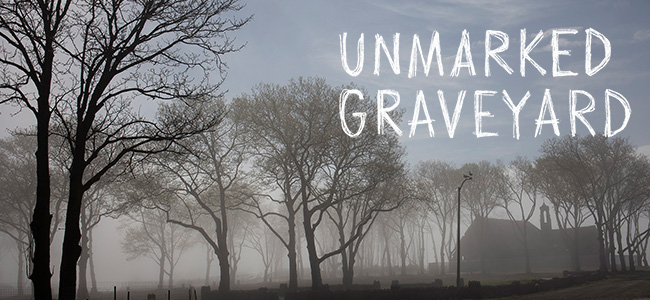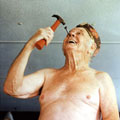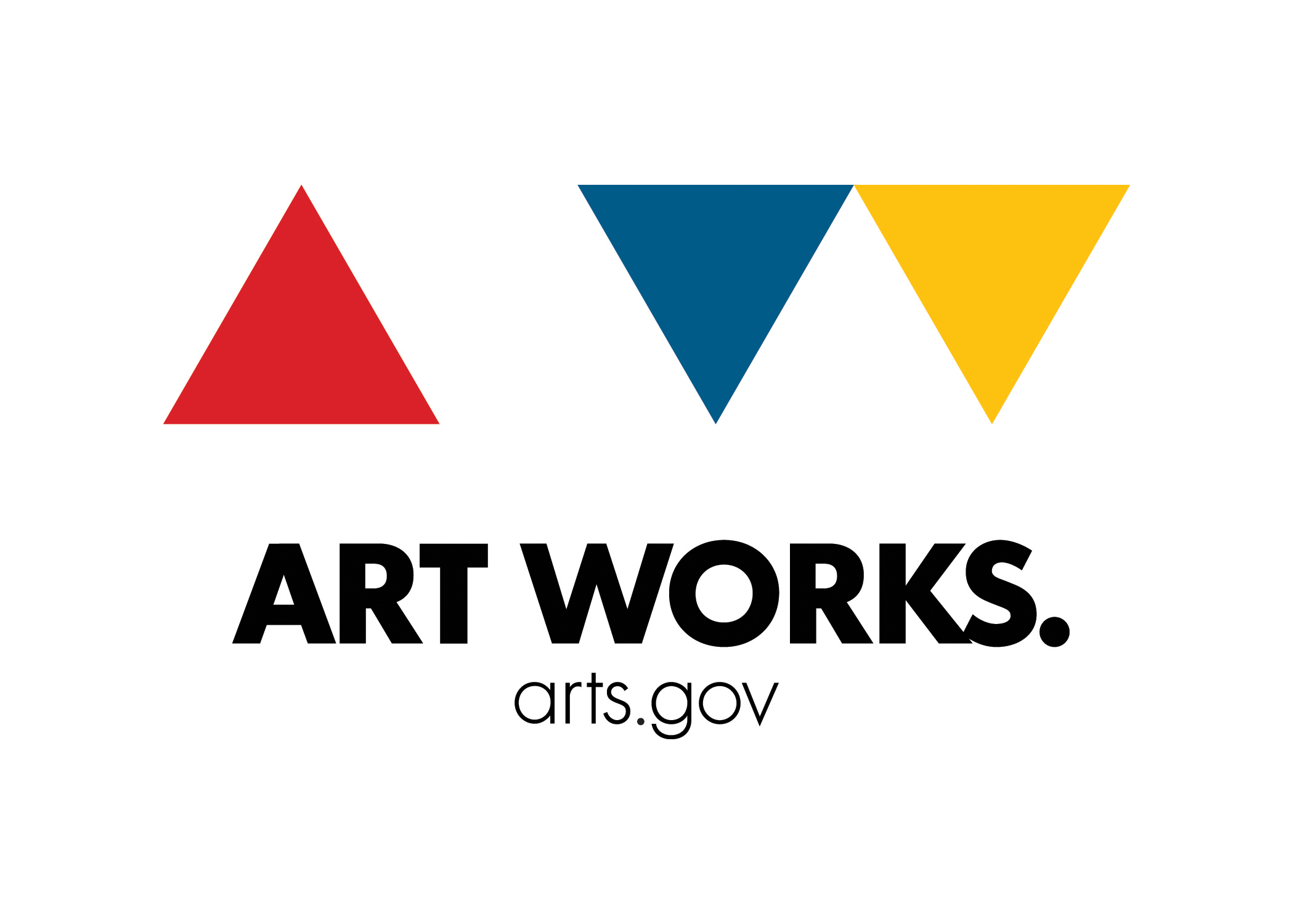[Sound of a fog horn and a boat engine]
JOE RICHMAN (host): On a recent rainy Saturday morning, I visited Hart Island for the first time. It’s New York City’s potter’s field. There are more than a million people buried there, on a narrow strip of land. And it’s not easy to visit. You have to get permission from the city. If they grant it, you show up at an industrial dock in the Bronx and ride a small ferry to the island.
PARK RANGER: Um, everybody has a designated area where they’re visiting their loved one. We will take you to that area.
RICHMAN: Then you get on a bus. A guard escorts you to the specific grave that you’re signed up to visit. In my case, plot 414. You’re not allowed to just wander around. Everywhere you look you can see simple white posts with numbers on them.
No names. Just 414, 383, 201. Each post represents a mass grave, containing about 150 coffins. The guards give you a little time to pay your respects. Then the bus picks you up and takes you back to the ferry.
RICHMAN: This is the unmarked graveyard. A series where we untangle mysteries from America’s largest public cemetery. I’m Joe Richman. If you’ve been listening to our series, you’ve already heard a few stories about people who ended up on Hart Island and the people they left behind. We have more stories coming up in the series, but today we’re doing something different. A bonus episode about Hart Island itself. For more than a century, Hart Island has been mostly off limits.
The fact that we were able to make a series of stories about this place, we owe a lot of that to a woman named Melinda Hunt, who runs the Hart Island Project. Here’s Radio Diaries Producer Alissa Escarce to tell you more about her story.
ALISSA ESCARCE: I haven’t met a lot of people as single mindedly committed to anything as HUNT is to Hart Island. She’s been documenting the place 30 years. I sat down with her recently to talk about it.
HUNT: Every inch of the city needs its own little advocate.
ESCARCE: Right. Hart Island is your corner.
HUNT: Yeah, it’s my, it’s my space. It’s my turf.
ESCARCE: Melinda first heard about Hart Island from a doctor. This was back in 1990, at the height of the AIDS epidemic.
HUNT: And she was describing how babies would be buried in shoeboxes in mass graves in this island in the Bronx. And at that time, I thought that was extraordinary.
ESCARCE: So, she went to the library and started reading old articles about this island.
New York City had been burying unclaimed bodies there since 1869. Over the years, the island had also been home to a prison and a POW camp and a drug rehab center. Melinda’s a visual artist, and she wanted to take pictures of this place. She teamed up with the photographer, Joel Sternfeld. The island was mostly closed to the public, though, so they had to get permission from the New York City Department of Correction, the agency that oversees jails.
It also managed Hard Island. And actually, the people burying bodies on the island were men incarcerated at the Rikers Island Jail nearby.
Melinda was finally able to visit for the first time in 1991.
HUNT: It was a very cool and cloudy day, late fall, and we rode on the ferry. Over to Hart Island with the morgue truck from the medical examiner with the bodies that were going to be buried that day and the bus load of inmates from Rikers Island.
And when we got over there, the correction officers were actually very Happy to have someone to talk to about what they were doing. And they gave us a tour of Hart Island, driving around. And then, because I was pregnant, actually on that first visit, they gave us the keys to their van, and I was allowed to drive this prison van around Hart Island to the locations that we were Looking at to photograph and I was really surprised at how beautiful it was as a location and how spiritual it felt. And I, I felt that somehow the story wasn’t quite as dark as I imagined.
ESCARCE: Could we look at a couple of those photos from your early trips?
HUNT: Uh, sure. This, yeah, this is the first time we saw a burial. The inmates are standing in a plot that is 60 feet long, 25 feet wide, and 8 feet deep, and they are by hand shoveling dirt, 4 feet of dirt, on top of. these boxes, I quickly learned that the inmates were the people most connected to these burials. Not only did they perform them, but many of them know somebody from their neighborhood or their family who was buried on Hart Island.
So, they understood the experience of losing someone in your community and having them disappear onto Hart Island.
ESCARCE: Melinda spent about three years photographing the island. The photos show a place that was sort of wild looking and overgrown. There were abandoned buildings and a big sign that said, prison, keep off.
And men unloading pine coffins off of a morgue truck. Each coffin had a person’s name scrawled on the side. In 1998, these photos were published in a book.
ESCARCE: So what happened after you published this book?
HUNT: Well, people started contacting me because in the book there’s a photo of a woman named Vicky Pavia who I helped arrange for her to visit on the 40th anniversary of her baby Denise’s birth and death.
And so people seeing this book felt that maybe there was hope that they could visit. And people from all sorts of backgrounds contact me for assistance. And I felt that Hart Island had this. stereotype of being a burial ground of the unwanted, um, of those people that we step over and see on the subways.
And I felt that when I was speaking to these families that that isn’t how they viewed their relative. And I felt that there was this stigma that was so unnecessary and really placed a weight on these families that carried from one generation to the next that it was a stain on the family To have somebody buried in this place this shameful place
ESCARCE: Some of these people were looking for proof that their relatives were buried on hard island but records of the burials there were hard to get Melinda decided to help them, and in this way, her work started expanding beyond art into a kind of activism.
HUNT: I was just trying to help one person initially find out where his father was buried and on what day. And this was a man who, both his parents committed suicide and he was adopted. And New York state law allows for him to find out who his birth parents were once he turned 18. So he, he started looking. He got a death certificate, but it didn’t have anything listed under cemetery.
So he very much wanted a confirmation that his father was buried on Hart Island.
ESCARCE: Melinda submitted a freedom of information request to get burial ledgers with information about this man’s parents. The ledgers were handwritten pieces of paper with people’s names and the dates that they’d been buried.
Then she got a lawyer.
HUNT: And the attorney said, It’s not worth getting just one. How many do you think they have going back to 1985? And I saw it for a minute, I said, 50, 000. And he said, let’s request 50, 000. So that was the first time that I realized that I was going to be working with quite a number of families.
There were thousands of people who wanted to know. What happened to the body of their relative? And many of these people were children who had lost a parent, and it’s a, it’s a much different feeling to know that your mother died versus your mother abandoned you. Mm hmm. So it’s extremely important to people to know for sure what happened to their relatives.
And I felt they had a right to know it.
ESCARCE: Melinda Hunt finally got access to the Hart Island burial ledgers in 2008. There were lists of all the burials, going back to the late 1970s. So, tens of thousands of names and dates. She used them to build this online database, where anyone can type in a person’s name and find out when they died. And when and where they were buried.
The database is pretty amazing to look through. Because on top of the names and dates, it has spaces where people can write messages about their loved ones. That’s actually how we found several of the stories in this series. I spent a few weeks combing through the database, reading these messages. Many were pretty raw.
Stories about hard lives and complicated family situations. But also about love. Here’s a note about a woman named Connie, written by her son. It says,
“At 11 years old, I lost my mom, and we didn’t know where she was buried because she didn’t want to be found. 27 years of not knowing where she was buried, and now I know. Love you and miss you so much. R. I. P. Mom.”
Or here’s another note I love, about a woman named Hisako Hasegawa. We’ll actually have an episode about her in a couple weeks. It says,
“Ms. Hasegawa lived in the hotel I worked at. She had no family that we know of. She was the sweetest old lady to us all. I was so sad to have learned of her passing while in her room, all alone.”
One of the notes that stood out to me especially was about Neil Harris, the man you heard about in episode one of this series. Here’s his mom, Susan, reading a missing persons flyer that she made after Neil went missing a few years ago.
SUSAN HURLBURT: Neil Harris was last seen in Inwood, New York on December 12th, 2014. He was last seen wearing a tan Carhartt jacket, black hoodie, blue jeans, tan work boots, and a backpack.
ESCARCE: Susan ultimately found out that her son was buried on Hart Island. And afterward, she wrote in the database,
“Never once did I give up on him. I was sure I was going to find my son. Just not in this way.”
Melinda and I looked at the note together.
HUNT: It says,
“Rest easy, my son, August 29th, 1984 to March 9th, 2017,” when he died. And there’s a photo from 2010 of him sitting on a couch.
ESCARCE: You know, I went with Susan to Hart Island. And she told me that when she first heard that he was buried on Hart Island that she really was upset and that the idea of him being there was hard for her.
But that talking to you about Hart Island changed her mind because you had described it as a beautiful and very peaceful place near the water and that it wasn’t a thing to be ashamed of. And so that just struck me as a testament to your work and the way that your work has reframed the way people perceive the place.
HUNT: I think that some artists, the importance is, is gallery shows and museums. For me… It’s city policy and reframing this terribly dark image of a place that is so damaging to so many people, so that they believe. That their life matters to the city of New York, that the lives of their relatives matter.
ESCARCE: A big part of how she’s done this has been by pushing the city to make it easier for family and friends to see where their loved ones are buried and to pay their respects. Basically, to make Hart Island feel more normal.
Without so much stigma, Melinda thinks more people might choose to be buried on Hart Island. That’s what composer Noah Creshevsky did. We told his story in episode 2. Here’s his husband David Sachs.
DAVID SACHS: The idea being…buried collectively in a, in a, what they used to call a pauper’s grave seemed very meaningful to him. And the more we talked about it, the more it seemed appealing, you know? The simplicity, the anonymity, the humility, and it was on the water, which he loved. For someone who was such an egalitarian, who believed genuinely in everyone’s equality, It was the right decision for him.
ESCARCE: Melinda’s pretty enthusiastic about people choosing Hart Island, partly to reduce the stigma around it, but also because she says burials there are better for the environment.
HUNT: The body is unembalmed in a plain pine box and will naturally turn to compost in about 20 years.
Most funeral directors offer cremation, which is not green because you’re turning a body into carbon. Most burials in cemeteries are now in concrete vaults. And they do that in cemeteries because You can have bodies much closer together without the ground collapsing and it’s easier to mow because as the bodies decompose it doesn’t become all lumpy and hillocky, so it’s what makes, you know, cemeteries look like these very manicured, you know, level ground and everything easy to maintain, but those in fact are not green, whereas Hard Island, The bodies decompose and become parkland.
ESCARCE: You’ve devoted now three decades of your life to Hart Island. What is it that has kept you doing this work for all these?
HUNT: I just think it’s a beautiful place. And unlike other parts of the city, there’s something about it that, brings about a sense of humility, just the scale of it, and the sense of being a small person in a big space, a little speck in the earth, so you know that your little existence is just a very brief moment, that, oh, these things that we worry about every day are so small. Relatively small when it comes to the rest of humanity and how brief human history really is.
ESCARCE: Thanks so much, Melinda.
HUNT: Thank you for having me.
RICHMAN: That was Melinda Hunt of the Hart Island Project with our producer Alissa Escarce.
Partly in response to Melinda’s efforts, in 2021, New York City transferred management of Hart Island from the Department of Correction to the city’s Parks Department. Today, incarcerated workers from Rikers Island no longer dig the graves.
Most of the abandoned buildings on the island have been removed. And just recently, the Parks Department announced that they plan to open Hart Island to the general public in the coming months. To learn more about Melinda Hunt’s work, visit Hartisland.net. And to see drone footage of the island, visit our website, radiodiaries.org.
The Radio Diaries team includes Alissa Escarce, Nellie Gilles, Mycah Hazel, Lena Engelstein, and myself. Our editors are Ben Shapiro and Deborah George. And thanks to Sarah Kate Kramer and Daniel Gross for their help with this project. We’re proud members of Radiotopia from PRX, a network of independent, creator owned, listener supported podcasts.
You can hear them all at radiotopia.fm. And Radio Diaries has support from the National Endowment for the Humanities. The Lily Auchincloss Foundation, New York City’s Department of Cultural Affairs, and from listeners like you.
Coming up on the Unmarked Graveyard, Hart Island is often seen as a place for the unrecognized or the unclaimed, but some stories don’t fit that script.
TIM PAGE: I do think there will come a time when people will realize that she’s one of America’s greatest writers, but after she died, Dawn Powell was really kind of forgotten.
RICHMAN: I’m Joe Richman of Radio Diaries. See you next week.








